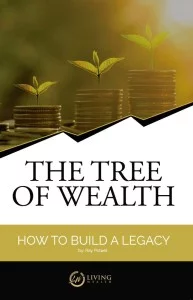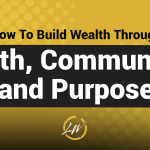Is fear impacting your wealth? In this episode of Dollars and Nonsense, Holly and Nate dig up the root of your financial worries and set out a plan to eliminate it. If you desire to provide a family legacy for future generations but aren’t eager to reduce your lifestyle, listen in and learn how to build your wealth differently. Escape the doubt and fear by taking charge of your money and thinking outside the box.
Also, Nate and Holly reveal:
- Break free from the bank’s control
- Start implementing infinite banking
- Pay yourself first
- Turn your liabilities into assets
Episode Takeaways:
Want Financial Freedom?

Start your journey to financial freedom with this first step.
Get our 122 page eBook The Tree of Wealth here now.
Podcast transcript for episode 11: Building Wealth Differently
Nate: In this episode, we will discuss how you can start building more wealth without having to decrease your lifestyle simply by kicking the bankers out of your life. She’s Holly, and she helps people find financial freedom.
Holly: And he’s Nate, and he makes sense out of money. This is Dollars and Nonsense. If you follow the herd, you will be slaughtered. Nate, many of us today have honestly been thinking about the future and what does that future look like. And most of us keep working really hard, and as we work hard, we keep buying more assets because that’s what we’ve been taught. Buy more assets, work harder, buy more assets. And at the end of the day, we don’t seem to have much more than our parents had or very little more. Yet a real fear, especially for me, living in an area which is a high-income area, it’s expensive to buy a home, many of my friends are concerned that their kids, once they grow up, won’t be able to ever afford a home. They might not be able to send them to university or college unless something changes (more government help, lower income-housing provided, more dependence on the banks). That their kids don’t have a future. That they are not going to able to live in the city or state where they currently live; that they’re going to have to move to Minnesota, Wyoming, or the Midwest so they can have a better quality of life. In the sense of they can buy a home and a house or have some land and do something with it versus being in Southern California where it’s expensive to buy a house and there’s very little land if that. And if you want to you have to have a lot of money most of the time, and they don’t have that. And they can’t even help their kids be able to buy a house in the future. Most of us have been taught our whole life, and as I talk to my friends and hear a lot, is, “Well I have to be saving for this and the only way my kids are going to do that is if we pass this legislative act to create lower income family [homes] or we keep the interest rates low with the banks so our kids can afford to do more loans, first homeowner loans. Or what if we can get more grant money and funding through the government to be able to send them to college so they can get a better job in order to buy a nicer house or home for their family? And what happens if they just have to rent an apartment?
Nate: So you’re saying there’s a lot of worry out there in California that the kids will never be able to afford a home because the housing prices are out of control?
Holly: Yeah. That was one of our initiatives in the elections—to create lower- income housing in the future, 10 or 20 years down the road, so that kids today can afford homes in the future.
Nate: I’m sure everyone is stressed out about the price of education, housing; there’s no jobs out there. It’s looking pretty bleak for the most part.
Holly: If you think out here in California, as my neighbor said, (I’ll probably talk about this in another episode as well), he and his wife were told when their kids were newborns—they started 529 programs—they were told they have to put $600 a month per kid into a program. And they said they couldn’t afford that. We can afford the $300 per kid, so we can pay for half of their education. And that’s at a public school; we’re not talking private. We’re talking at a public state school. [That’s] the reality of how much it will be. The fear that people have is we’ve been programmed in our life to let fear control us and to just do what our parents did and hopefully we’ll do a little better. So if they borrowed from the banks and let the government provide the subsidies—just looking at the baby boomer population retiring, will social security be there in the future? And how many people are dependent on it being there in the future? We’ve been programmed to let a lot of fear and worry control our lives and give control of our money over to banks and the government.
Nate: Mainly because of that fear. The issue is most people’s strategy to overcoming these big issues that you’re talking about, Holly, is the plan [that] the only way to make a change is you have to start saving more money. For the kids who are going to school, or even if your children in the future just have to save more to live the same type of lifestyle that we’re living today or their parents are living. The biggest issue is that to save more, many times they’re trying to get you to tighten the faucets down and reduce your lifestyle drastically so you can store up money and hope you can make a change at some point and your kids won’t have to suffer through that.
Holly: You’re absolutely right.
Nate: Most conventional planners, as far as the conventional way, they say that can solve the problems of rising costs everywhere you look . . . you’re going to have to save more money to afford the same lifestyle in the future or to be retired one day, especially with social security going into the crapshoot. Also, your kids are going to have to save a ton of money just to be able to make a down payment on a home and buy a home with the prices skyrocketing. The issue is that for you to save more many times they say you’ll have to tighten the faucets and cut out expenses everywhere, so you’ll have to reduce your lifestyle just to be able to afford the things in the future that you’re wanting to do. Of course, we think outside of the box, and we’d like to find a different way to be able to build wealth that doesn’t force you to reduce your lifestyle to be able to afford the things you want to do in the future for you and your family.
Holly: We’re going to take a quick break and go to our sponsors. When we come back, we’re going to answer the question of do you really want to change your lifestyle in order to have more money later on in life or is there another option. Here’s a note from our sponsors.
Holly: Welcome back. Statistically, Nate, we have mentioned in the past, like you said, we’re going to have to save more money. We’re going to have to either work seven years longer or save 25% more to be able to retire accordingly. To be able to provide our kids college you’re going to have to put more and more money away. What those programs depend upon is us taking our money and putting it into a government-funded program or a bank and giving that money to a bank. But there are some other options out there. One of the biggest keys is understanding what happens to your money and what goes on with it when you give it to a bank. And how much does a bank make traditionally and on average in interest just on your money.
Nate: Yeah, the average individual—you can find this in Nelson Nash’s book called Becoming Your Own Banker—in that book he said the average American can spend between 25-35 percent of all the income that they earn, their after-tax income, will actually go to a bank in interest and finance costs over their lifetime. Twenty-five to 35% of their income will go to interest and finance costs. The key is simply when most people are trying to save money, they’re saying just start saving 10% of your income then you’ll actually be doing okay. That’s the mark in the sand that most people try to shoot for. Are you really going to be getting ahead if you’re saving 10% of all the money that comes in, but you’re giving the bank 25-35% of what comes in between the credit cards, the boat loan, the car loans, the mortgage, the student debt, the business debt. It easily can get 25-35% of your income out the door, never see it again, gone to a bank. Yet you’re trying to save 10%. You’re never going to get ahead doing that.
Holly: I want people to understand—think of it in dollars or in cents. If you’re giving 25 cents away, and you’re keeping 10 cents of every dollar you make in your life, it doesn’t matter the rate of return on that, you’re never going to get the 25 cents back. It’s walking out the door. So if somebody tells you just save that 10 cents, and you know what, keep giving that 25/35 cents away, just keep giving it to the bank. You have to ask yourself will you ever get ahead. It doesn’t matter what the rate of return is or the risk you take with the 10 cents you’re saving, you’re never going to get ahead. Never.
Nate: What we’ve really found is that it’s so much more freeing and you have so much more control and comfort instead of trying to focus on getting a high rate of return on the ten cents you’re saving—which many times to get that high rate of return you have to go take more risk which is also what causes people to have ulcers—instead of you having to take the risk and stress, living life the conventional way, if you would truly learn to kick the bankers out of your life, cut them out of the picture, you would be able to make so much money on your money, you would never dream of having that kind of money just by saving it. That brings us back, Holly, to where we were to begin with. Most people think they have to just save not 10 % but they have to start working harder and earning more or something so they can start saving not 10 cents but 15 cents or 20 cents to be able to get to where they want to go. What I’d rather do is figure out a way to recapture all the interest I’m currently paying on credit cards, student debt, car loans, mortgages, business debt, all those things, and by recapturing that I’d have to earn 100-200% rate of return on my savings to get back the volume that I could receive simply by focusing on banking and not the conventional way, which is really designed to keep you in debt and enslaved by locking the money up and giving up control of it.
Holly: Really what we’re talking about here is being able to understand that all we want to do is teach you how to recapture debt. Most of us in our lives have never been taught that key of using the infinite banking concept and not only purchasing that permanent whole life insurance policy but taking it a step further and paying yourself. You are going to become the banker, and you’re going to pay yourself and recapture that debt. And instead of giving that 25 cents and that 35 cents to the banks, you’re going to bring that money back to you. It’s simply one simple step that you can change the whole process of your life to add wealth to your family. And to give your kids what you have today to be able to have in the future. But it’s a matter of taking that step. What we’ve been taught to do is borrow the money, pay the bank back, take out another loan, pay the bank back. And we’re talking about in every area. It’s not just big areas of life that you’re spending money. It’s on the gasoline. It’s on the vacation. It’s on the food. It’s on the eating out. It’s on the entertainment. Actually being able to recapture that money you’re spending and give it back to yourself.
Nate: Most people listening would agree with us that they don’t really like being in debt. Everyone would like to have their house paid off. All of their cars paid off. Would like to not have student debt and credit cards. But some way or another we’ve found ourselves carrying those types of things. The reasoning I think that we all find ourselves, or most of us do, is simply because of the focus that the world has put us into—as you mentioned Holly—[which] is work hard and buy some assets and hope that those assets generate you a rate of return. It’s not a bad idea, but the issue is many people are not earning a near a high enough rate of return to make up for the fact that because they don’t have the money, because it’s sitting somewhere else in some other asset, they have to go to the bank and they’re giving more to the bank, drastically more, than they’re keeping for themselves to buy those assets. So you can go broke doing it. Essentially what I find people doing all the time is living paycheck to paycheck. They’re essentially broke, but they have a retirement program. There’s no freedom there.
Holly: It’s the philosophy, Nate, that we’ve been taught in our life that basically when we get a paycheck and it’s deposited in the bank, direct deposited or go to the bank to deposit it, we take that money and we go and pay all the bills. And we hopefully have enough to live on to make it to the end of the month. Instead of having the philosophy of why don’t we pay ourselves first, save first for us and then go and pay the bills. And it’s simply changing that mindset up. We’ve never stopped to pay ourselves first and then said now let’s use that money and use it again to pay those bills and be able to do it. Because no one’s ever taught us to do it. They’ve taught us to deposit the money and pay the bills and then live on what you make. And most of us can’t do that or we’re not making enough to live on or we’re not living within our means. But if we would actually pay ourselves first, we would save first. What I call being a saver first and then the spender.
Nate: Yeah and that’s really fundamental in building wealth in any way. What we’re talking about is building wealth differently. What’s amazing is if you kick the banks out you can actually build more wealth than you thought you ever could without ever having to change your lifestyle. The conventional way is you just have to work harder and save more so you can have more. What we’ve found is you can recapture all the payments that are currently going to a bank and use that money, that’s already accounted for in your lifestyle. You won’t have to change your lifestyle a bit. But the amount going into savings is going to be drastically higher because you’re no longer transferring money to someone else, to another bank, and if that money can be used to grow with interest on top of what we are already saving—as you said paying yourself first—you can build so much more than you ever thought possible . . . with the goal of being able to live in retirement and do other things. But also, as we mentioned in the beginning, support your kids. What do you think if your kids could come to you for a car loan or a house loan or something like that? And instead of paying a bank back, they can pay you back, so the family gets to keep all the money. Then the money they paid back to you allowed you to increase your lifestyle, because that’s a steam of income that you can actually utilize in your life, but upon death all that money would pass to the kids. You’re starting to see that those same worries about buying a house or affording college in the future can be moot because your focus is banking versus the old way of retirement savings and investing. There’s so much more freedom there that you can build wealth differently, and you’ll be to accomplish the things that you didn’t think you could based on the environment we are in.
Nate: You’ve essentially turned your liabilities into assets with the same money. Instead of having to make a payment to a bank that goes to them and pockets to the shareholders of the bank, if you’re able to recapture that payment and bring it back to an entity that you control, that same money can make you wealthier instead of someone else without having to change anything at all. It’s just by changing what a loan is from somebody else’s bank back to you, you’ve turned a liability into an asset, which is how the wealthy truly build their wealth—by changing the way they think of liabilities to assets.
Holly: And it removes the worry from your life. I was telling Nate earlier I don’t worry about if my kids will be able to live in Southern California. I don’t worry about if they’re going to be able to go college or a university or if we’ll be able to afford it because I’ve been able to create wealth for them, so I know when as they get older, they’re going to know how money works, and they’re going to be their own banker. My hope and my goal is that they never have to use a conventional bank to ever borrow money because they’re going to understand the power of infinite banking and how to recapture debt and pay themselves back and see those loans as assets and not liabilities.
Nate: That’s what we mean by building wealth differently. Instead of going out and stuffing money into retirement programs, the 10 cents that you’re saving and continuing to spend 35 cents to the banks, focus on recapturing that 35 cents that’s currently going to a bank and you can have so much more than you thought you could simply by changing your focus from the conventional way to the banking way, which not too many people are doing. And take it one step further as a family and understand we can keep all the money in the family just by you changing it at the beginning but then of course lending money to your children and they can pay you back. All the payments that normally go out the door can stay in the family and be reused again for generations and generations.
Holly: It’s an amazing way to live. And it’s freeing. I don’t honestly stress in my life about the assets we’re going to buy or how are we going to afford this because I truly know that I’m not dependent on a bank to say, “Yes, here’s the mortgage for this or that.” I truly understand and know that we have the resources available to pay ourselves back. So we can go on that vacation or we can buy that car. And it’s not me going through a loan approval to do it or saying what if I lose my job and I can’t pay that loan back, and they’re going to come take the car. It’s really being able to understand that you can have complete control of your money, and you can create wealth for your family. And some of you may say that I would never want to loan my kids the money for a car or a down payment on a house, but the reality is you have to ask yourself—they’re going to go buy the car or they’re going to get the down payment somehow or another, and they’re either going to pay you back or they’re going to pay a conventional bank back. And that money and that wealth is then going to leave the family and go to somebody else, potentially and more than likely the bankers who own the bank.
Nate: Exactly. So this has been Dollars and Nonsense. If you follow the herd, you will be slaughtered.
Holly: Get free resources and transcripts for this episode by visiting livingwealth.com/e11.









